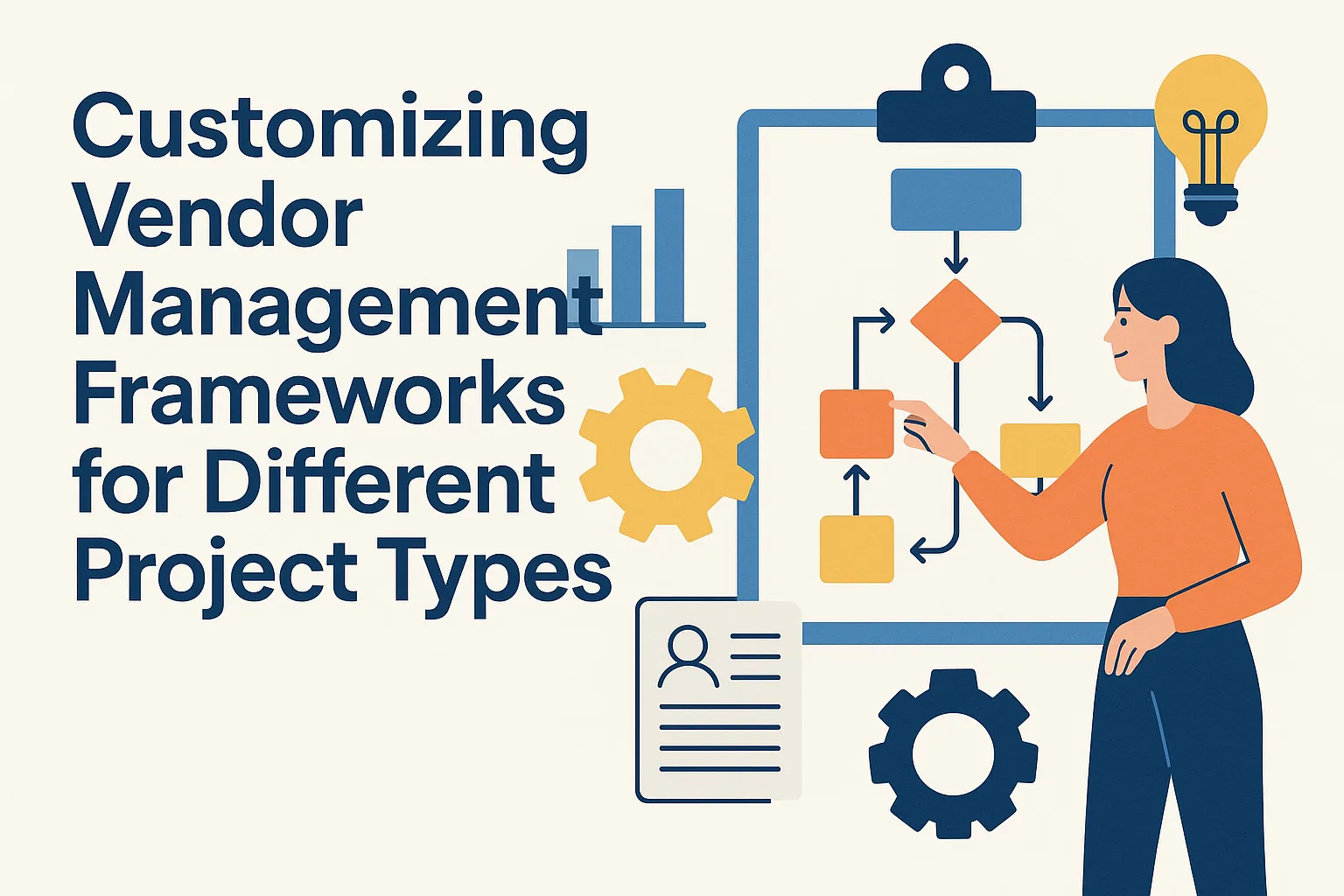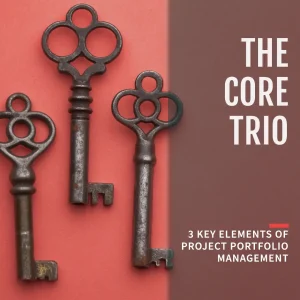Introduction to Vendor Management Frameworks
A vendor management framework serves as a structured approach to managing relationships with external suppliers who provide goods and services essential for project success. These frameworks are designed to streamline processes, enhance communication, and ensure that all vendor-related activities align with the project’s objectives.
Definition of Vendor Management Frameworks
A vendor management framework encompasses the policies, procedures, and tools that organizations use to manage their interactions with vendors. It includes aspects such as vendor selection, contract negotiation, performance monitoring, and risk management. By establishing a clear framework, organizations can ensure that they maintain effective relationships with their vendors, which is crucial for achieving project goals and delivering value to stakeholders [1][11].
Importance of Vendor Management in Project Success
Effective vendor management is pivotal to the success of any project. It provides several key benefits:
- Enhanced Visibility: A well-implemented vendor management framework offers real-time visibility into procurement processes, fostering transparency and trust among stakeholders [2].
- Risk Mitigation: By developing a vendor risk management strategy, organizations can identify, assess, and mitigate potential risks associated with vendor relationships, whether they are financial, operational, or reputational [5].
- Performance Improvement: Establishing clear vendor management policies helps drive performance improvements and ensures that vendors meet the required standards and deliverables [9].
Overview of Different Project Methodologies
Project management methodologies can significantly influence how vendor management frameworks are tailored. Here are some common methodologies:
- Agile: This iterative approach emphasizes flexibility and collaboration. Vendor management in Agile projects often requires close communication and adaptability to changing project requirements.
- Waterfall: A linear and sequential methodology, Waterfall projects benefit from a structured vendor management framework that outlines clear phases and deliverables, ensuring that vendors adhere to timelines and specifications.
- Hybrid: Combining elements of both Agile and Waterfall, hybrid methodologies necessitate a flexible vendor management approach that can accommodate both structured planning and iterative development.
By understanding the nuances of these methodologies, project managers can customize their vendor management practices to better align with the specific needs and dynamics of their projects. This tailored approach not only enhances vendor relationships but also contributes to overall project success [6][12].
Understanding the Needs of Different Project Types
The approach to vendor management can significantly vary based on the type of project being undertaken. Each project type comes with its own set of characteristics, requirements, and challenges that influence how vendors are selected, managed, and evaluated. Here’s a closer look at how different project types shape vendor management practices.
Characteristics of Various Project Types
Construction Projects:
- Complexity and Scale: Construction projects often involve multiple stakeholders, including contractors, subcontractors, and suppliers. The complexity necessitates a robust vendor management framework to ensure compliance with safety regulations and quality standards.
- Long Duration: These projects typically span several months or years, requiring ongoing vendor engagement and performance monitoring throughout the project lifecycle.
IT Projects:
- Rapid Evolution: The IT landscape is constantly changing, which means that vendors must be adaptable and up-to-date with the latest technologies. This requires project managers to prioritize vendor performance records and their ability to innovate.
- Security and Compliance: Given the sensitive nature of data in IT projects, security and compliance become critical factors in vendor selection and management.
Marketing Projects:
- Creativity and Flexibility: Marketing projects often require vendors who can provide creative solutions and adapt to changing market conditions. This necessitates a more flexible vendor management approach that allows for quick adjustments.
- Shorter Timelines: Marketing campaigns may have tight deadlines, which means that vendor engagement must be efficient and responsive to ensure timely delivery of services.
Specific Vendor Needs for Each Project Type
- Construction: Vendors must demonstrate reliability in terms of delivery schedules and quality of materials. Performance evaluations should focus on adherence to timelines and safety standards.
- IT: Vendors should have a proven track record in technology implementation and support. Security certifications and compliance with industry standards are essential.
- Marketing: Vendors need to showcase creativity and past campaign successes. Their ability to pivot quickly in response to market feedback is crucial for project success.
How Project Scope, Budget, and Timeline Affect Vendor Engagement
- Project Scope: A larger scope often requires a more extensive vendor network, necessitating a comprehensive vendor management framework that includes selection criteria, contract management, and performance evaluation processes. For instance, construction projects may require multiple vendors for different aspects, while IT projects might focus on a few specialized vendors.
- Budget: Budget constraints can dictate the level of vendor engagement. In projects with limited budgets, project managers may need to prioritize cost-effective vendors while ensuring that quality is not compromised. This is particularly relevant in marketing projects where ROI is critical.
- Timeline: The urgency of project timelines can influence vendor selection and management strategies. For example, in IT projects with tight deadlines, project managers may opt for vendors with proven quick turnaround capabilities, while in construction, timelines may allow for more thorough vendor vetting processes.
Tailoring Vendor Management for Agile Projects
Particularly within Agile methodologies, the approach to vendor management must be adaptable and responsive to the dynamic nature of Agile practices. Here’s an exploration of how to customize vendor management frameworks to align with Agile principles and enhance project outcomes.
Overview of Agile Principles and Practices
Agile project management is characterized by its emphasis on flexibility, collaboration, and iterative progress. Key principles include:
- Customer Collaboration: Agile methodologies prioritize customer feedback and involvement throughout the project lifecycle, ensuring that the end product meets user needs effectively [1].
- Iterative Development: Projects are broken down into smaller, manageable increments or sprints, allowing teams to adapt to changes quickly and deliver value continuously [1].
- Cross-Functional Teams: Agile promotes the formation of self-organizing teams that encompass various skills, fostering collaboration and innovation [1].
These principles necessitate a vendor management approach that is equally flexible and collaborative.
Importance of Flexibility and Collaboration with Vendors in Agile
In Agile environments, the relationship with vendors is crucial. The following points highlight the importance of flexibility and collaboration:
- Responsive Partnerships: Agile projects often face changing requirements. Vendors must be willing to adapt their services and deliverables in response to evolving project needs, which requires a strong collaborative relationship [2].
- Shared Goals: Establishing common objectives between project teams and vendors enhances alignment and ensures that all parties are working towards the same outcomes. This shared vision is vital for successful project delivery [2].
- Continuous Feedback Loops: Regular communication and feedback between project teams and vendors facilitate quick adjustments and improvements, which is a cornerstone of Agile methodologies [2].
Best Practices for Integrating Vendors in Agile Sprints and Iterations
To effectively integrate vendors into Agile sprints and iterations, consider the following best practices:
- Involve Vendors Early: Engage vendors during the planning phase to ensure they understand project goals and can contribute effectively from the outset. This early involvement fosters a sense of ownership and commitment [3].
- Define Clear Roles and Responsibilities: Clearly outline the roles of vendors within Agile teams to avoid confusion and ensure accountability. This clarity helps streamline collaboration and enhances productivity [3].
- Utilize Agile Tools and Techniques: Leverage Agile tools such as Kanban boards or Scrum meetings to keep vendors informed and engaged throughout the project lifecycle. These tools facilitate transparency and encourage active participation [3].
- Regular Review and Retrospectives: Conduct regular reviews and retrospectives that include vendor input. This practice not only helps in assessing progress but also allows for collective learning and improvement [3].
By tailoring vendor management practices to fit Agile methodologies, project managers can enhance collaboration, improve responsiveness, and ultimately drive project success. Emphasizing flexibility and continuous engagement with vendors will ensure that Agile projects can adapt to changes and deliver value effectively.
Adapting Vendor Management for Waterfall Projects
The Waterfall methodology is characterized by its linear and sequential approach, making it essential for project managers to adapt their vendor management frameworks accordingly. This section outlines the structure of Waterfall projects, the role of vendors throughout each phase, and effective strategies for vendor selection, contract management, and performance evaluation.
Overview of Waterfall Project Structure and Phases
The Waterfall methodology consists of distinct phases that flow in a linear progression, typically including:
- Requirements: Gathering and documenting all project needs from stakeholders.
- Design: Creating a detailed design based on the requirements.
- Implementation: Developing the project deliverables.
- Verification: Testing the deliverables to ensure they meet the specified requirements.
- Maintenance: Ongoing support and updates post-deployment.
This structured approach allows for meticulous planning and clear objectives, which are crucial for managing vendor relationships effectively throughout the project lifecycle [3][11][15].
Role of Vendors in Each Phase of a Waterfall Project
Vendors play a critical role in each phase of a Waterfall project:
- Requirements Phase: Vendors can provide insights and expertise that help define project requirements, ensuring that the specifications are realistic and achievable.
- Design Phase: During this phase, vendors may contribute to the design process by offering specialized knowledge or tools that enhance the project’s design quality.
- Implementation Phase: Vendors are often responsible for delivering specific components or services, making their reliability and quality crucial for the project’s success.
- Verification Phase: Vendors may assist in testing and quality assurance, ensuring that the deliverables meet the established standards and requirements.
- Maintenance Phase: Post-deployment, vendors can provide ongoing support and updates, which are essential for the long-term success of the project [11][12][13].
Strategies for Vendor Selection, Contract Management, and Performance Evaluation in Waterfall
To effectively manage vendors in a Waterfall project, consider the following strategies:
Vendor Selection:
- Define Clear Criteria: Establish specific criteria for vendor selection based on the project’s requirements and the vendor’s expertise in relevant areas.
- Evaluate Past Performance: Assess potential vendors based on their previous work, reliability, and ability to meet deadlines, which is crucial in a linear project structure [14].
Contract Management:
- Detailed Contracts: Create comprehensive contracts that outline expectations, deliverables, timelines, and penalties for non-compliance. This clarity is vital in a Waterfall approach where each phase depends on the completion of the previous one [14].
- Regular Communication: Maintain open lines of communication with vendors to address any issues promptly and ensure alignment with project goals.
Performance Evaluation:
- Set Milestones: Establish performance milestones that align with the Waterfall phases, allowing for regular assessment of vendor contributions at each stage.
- Feedback Mechanisms: Implement feedback loops to evaluate vendor performance continuously, ensuring that any necessary adjustments can be made before moving to the next phase [14][15].
By tailoring vendor management practices to fit the Waterfall methodology, project managers can enhance collaboration, ensure quality deliverables, and ultimately drive project success. This structured approach not only clarifies expectations but also fosters a productive partnership between project teams and vendors throughout the project lifecycle.
Customizing Vendor Management for Hybrid Projects
The adoption of Hybrid methodologies—blending Agile and Waterfall approaches—has become increasingly prevalent. This section explores how project managers can effectively tailor vendor management frameworks to suit the unique demands of Hybrid projects.
Definition and Characteristics of Hybrid Project Methodologies
Hybrid project management combines the structured planning of Waterfall with the flexibility of Agile, creating a dynamic approach that can adapt to various project needs. Key characteristics include:
- Flexibility: Hybrid methodologies allow for adjustments in project scope and timelines, accommodating changes in requirements as they arise.
- Structured Planning: While Agile promotes iterative progress, the Waterfall component ensures that there is a clear roadmap and defined milestones, which is essential for vendor management.
- Customization: Project managers can select elements from both methodologies to create a tailored approach that reflects the specific context of the project, including its size, complexity, and industry requirements [2][3][6].
Challenges and Opportunities in Managing Vendors Across Different Methodologies
Managing vendors in a Hybrid project environment presents both challenges and opportunities:
- Communication Gaps: Different methodologies may lead to varying expectations and communication styles between project teams and vendors. Agile emphasizes collaboration and rapid feedback, while Waterfall relies on detailed documentation and upfront planning. This can create misunderstandings if not managed properly [1].
- Vendor Adaptability: Vendors may need to adapt their processes to align with the Hybrid approach. This can be an opportunity for project managers to foster stronger partnerships by involving vendors in the planning stages and encouraging their input on Agile practices [1][5].
- Resource Allocation: Balancing resources between Agile sprints and Waterfall phases can be challenging. Project managers must ensure that vendors are adequately resourced to meet the demands of both methodologies, which may require flexible contracts and clear performance metrics [1][4].
Strategies for Integrating Vendor Management Processes in Both Agile and Waterfall Elements
To effectively integrate vendor management processes within a Hybrid framework, project managers can employ several strategies:
- Establish Clear Communication Channels: Create a communication plan that accommodates both Agile and Waterfall practices. Regular check-ins and updates can help ensure that all parties are aligned and that any issues are addressed promptly [1][2].
- Define Roles and Responsibilities: Clearly outline the roles of vendors within the project, specifying how they will contribute to both Agile iterations and Waterfall phases. This clarity helps in managing expectations and accountability [5][6].
- Utilize Adaptive Vendor Management Frameworks: Implement a vendor management framework that is flexible enough to accommodate the nuances of both methodologies. This may involve using tools that support Agile practices, such as Kanban boards, alongside traditional project management tools that align with Waterfall [10][14].
- Foster Collaborative Relationships: Encourage a collaborative environment where vendors are seen as partners rather than just service providers. Involve them in planning sessions and decision-making processes to leverage their expertise and insights [1][3][5].
By customizing vendor management practices to fit Hybrid project methodologies, project managers can enhance collaboration, improve project outcomes, and create a more responsive and efficient project environment. This tailored approach not only addresses the complexities of managing vendors across different methodologies but also capitalizes on the strengths of both Agile and Waterfall frameworks.
Tools and Technologies for Effective Vendor Management
The integration of a robust vendor management framework is essential for ensuring that projects run smoothly and efficiently. As project managers across various industries seek to tailor their vendor management practices to fit different project methodologies, leveraging the right tools and technologies becomes paramount. Here’s an overview of how technology can enhance vendor management, along with examples of successful implementations.
Overview of Vendor Management Software and Tools
Vendor management software (VMS) serves as a centralized platform that streamlines the processes involved in managing vendor relationships. These tools facilitate various functions, including:
- Centralized Information Management: VMS allows project managers to store and access vendor information in one place, making it easier to track performance and compliance [1].
- Automated Processes: Many tools automate time-consuming tasks such as contract management, performance reviews, and billing, which can significantly reduce administrative overhead [1][11].
- Analytics and Reporting: Advanced analytics tools help project managers track key performance indicators (KPIs) and identify trends, enabling proactive decision-making [11].
Benefits of Using Technology for Tracking and Communication
The adoption of technology in vendor management offers several benefits that enhance overall project outcomes:
- Improved Communication: Tools like project management software facilitate real-time collaboration between project teams and vendors, ensuring that everyone is aligned on project goals and timelines [14].
- Enhanced Visibility: With centralized dashboards, project managers can monitor vendor performance and project progress at a glance, allowing for timely interventions when issues arise [11].
- Cost Efficiency: By automating processes and improving vendor performance tracking, organizations can reduce costs associated with vendor management, ultimately leading to better budget adherence [2][10].
Case Studies or Examples of Successful Tool Implementation in Various Project Types
- IT Project Management: A leading tech company implemented a specialized IT vendor management tool that integrated with their existing project management software. This allowed them to streamline vendor selection and performance tracking, resulting in a 20% reduction in project delays due to vendor-related issues.
- Construction Projects: A construction firm adopted a VMS that included features for contract management and compliance tracking. By utilizing this tool, they improved their vendor onboarding process, which led to a 15% increase in project delivery speed and enhanced quality control.
- Marketing Campaigns: A marketing agency used a collaborative platform to manage relationships with multiple vendors for a large campaign. The tool enabled real-time updates and feedback, which improved communication and resulted in a 30% increase in campaign effectiveness due to better alignment with vendor capabilities.
Common Challenges in Vendor Management Across Project Types
Effectively managing vendors is crucial for the success of any project. However, project managers often encounter a variety of challenges that can hinder the vendor management process. Understanding these challenges is essential for tailoring vendor management frameworks to fit different project methodologies. Here are some common challenges faced by project managers across various industries:
1. Communication Barriers and Cultural Differences
- Diverse Communication Styles: Vendors may come from different cultural backgrounds, leading to varied communication styles and expectations. This can result in misunderstandings and misinterpretations of project requirements and deliverables.
- Language Proficiency: Language differences can exacerbate communication issues, making it difficult to convey critical information clearly and effectively. This can lead to delays and errors in project execution [2][10].
2. Managing Vendor Performance and Expectations
- Performance Monitoring: Keeping track of vendor performance can be challenging, especially when multiple vendors are involved. Project managers must establish clear performance metrics and regularly assess vendor outputs to ensure they meet project standards [6][12].
- Expectation Alignment: Aligning vendor capabilities with project expectations is vital. Discrepancies between what project managers expect and what vendors can deliver can lead to dissatisfaction and project delays. This requires ongoing dialogue and adjustment of expectations throughout the project lifecycle [5][10].
3. Strategies to Overcome Common Vendor Management Pitfalls
- Leverage Technology: Implementing Vendor Management Systems (VMS) can help centralize information, automate tasks, and streamline communication. This technology can provide a single pane of glass for project managers to monitor vendor performance and manage relationships effectively [14].
- Establish Clear Governance: Developing a robust governance framework is essential for managing vendor relationships. This includes defining roles, responsibilities, and processes for vendor engagement, which can help mitigate risks associated with vendor management [9][12].
- Regular Training and Development: Providing training for both project teams and vendors on cultural awareness and communication can help bridge gaps and foster better collaboration. This proactive approach can reduce misunderstandings and enhance overall project performance [4][10].
By recognizing and addressing these challenges, project managers can customize their vendor management frameworks to better suit the specific needs of their projects, ultimately leading to improved outcomes and stronger vendor partnerships.
Conclusion: The Future of Vendor Management in Project Management
In the ever-evolving landscape of project management, the significance of customizing vendor management frameworks cannot be overstated. Tailoring these frameworks to align with specific project methodologies—be it Agile, Waterfall, or Lean—ensures that project managers can effectively meet the unique demands of their projects and stakeholders. A well-structured vendor management approach not only enhances operational efficiency but also fosters stronger relationships with suppliers, ultimately contributing to project success.
Project managers are encouraged to take a proactive stance in assessing their project types and the corresponding vendor needs. Understanding the nuances of each project methodology allows for the identification of the most suitable vendor management practices. For instance, Agile projects may benefit from a more flexible and collaborative vendor relationship, while Waterfall projects might require a more structured and formalized approach to vendor interactions. By recognizing these differences, project managers can optimize their vendor management strategies to better support their project goals.
Moreover, the landscape of vendor management is continuously changing, driven by advancements in technology and shifts in market dynamics. Therefore, it is crucial for project managers to commit to ongoing learning and adaptation in their vendor management practices. Engaging with industry best practices, attending workshops, and leveraging new tools can provide valuable insights that enhance vendor management capabilities. By fostering a culture of continuous improvement, project managers can ensure that their vendor management frameworks remain relevant and effective in meeting the challenges of future projects.
In summary, the future of vendor management in project management lies in the ability to customize frameworks to fit diverse project types. By doing so, project managers can not only improve project outcomes but also build resilient and productive vendor relationships that stand the test of time.
Find out more about Shaun Stoltz https://www.shaunstoltz.com/about/.
This post was written by an AI and reviewed/edited by a human.



